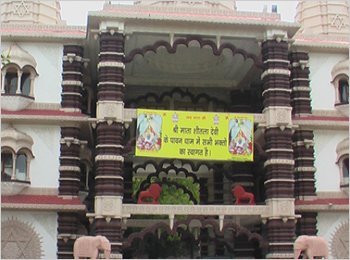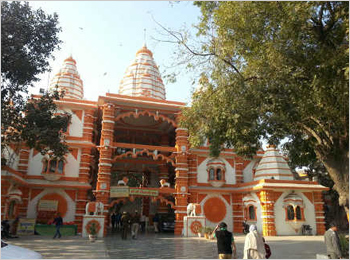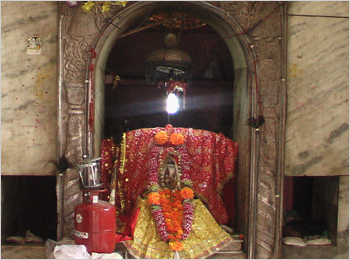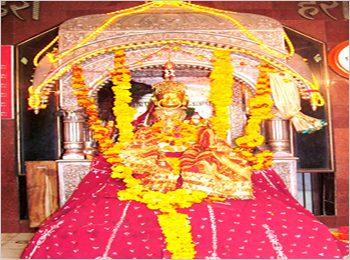- Shakti
Sheetala Devi Temple
- Haryana
- View on map
- Tell us about this temple
Overview
Shitala (Sheetala), also called Sitala is an ancient folk deity widely worshipped by many faiths in North India, West Bengal, Nepal, Bangladesh and Pakistan as the pox-goddess. She is the Goddess who cures poxes, sores, ghouls, pustules and diseases
About the temple

The presiding deity of sheetala devi temple is Mata Sheetala Devi, which is also referred to as Shakti Peeth.Situated near a pond at Gurgaon village, a suburb of Guru Dronacharya's birth place, in the state of Haryana, sheetala devi temple witnesses hordes of pilgrims throughout the year, except during the month of Shravana (July-August). During the month of Chaitra (March-April), this place resembles like Kumbh-Mela. There is a heavy rush of pilgrims especially on Mondays of this month.
About the Deity

Shitala literally means "one who cools" in Sanskrit. Shitala is worshipped under different names in various parts of the subcontinent. Shitala is more often called Ma (‘mother’) and is worshipped by Hindus, Buddhists and tribal communities. She is mentioned in Tantric and Puranic literature and her later appearance in vernacular texts (such as the Bengali 17th century Shitala-mangal-kabyas, ‘auspicious poetry’) has contributed to strengthen her status.
Shitala is primarily popular among the people of North India. In some traditions she is identified with an aspect of Parvati, the consort of Shiva. Shitala is addressed as Mother, as a seasonal goddess (Vasant, i.e. Spring) and with honorific titles such as Thakurani, Jagrani (Queen of the World), Karunamayi (She who is full of mercy), Mangala (The Auspicious One), Bhagavati (The Goddess), Dayamayi (She who is Full of Grace and Kindness).The role of Shitala in South India is taken by the Goddess Mariamman, who is worshipped by the Dravidian-speaking people.
In Gurugram of Haryana state, Shitala mata is considered to be Kripi (wife of Guru Dronacharya) and worshiped there in Sheetla Mata Mandir Gurgaon.
Legend and stories

Three legends are quoted regarding the building of the present temple of Shri Sheetla devi. The first legend says that there lived a poor carpenter at Farukh Nagar, who had a beautiful daughter. When she became of marriageable age her fame as a beauty spread all over the land. The Mughal ruler sent a message to the carpenter, asking his daughters hand in marriage. The carpenter did not like to give away his daughter to a person from a different religion and so appealed to King Surajmal of Bharatpur.The king refused to interfere, saying the case belonged to another kingdom. As the disappointed carpenter was returning, he met Prince Bharatpur, son of King Surajmal. The carpenter narrated his condition to the prince. The prince took up the matter with his father, but the king was adamant. This resulted in the prince revolting against his father and he attacked Delhi. Legend says that while proceeding towards Delhi, the Prince passed through Gurugaon and he pledged to the Devi that if he returns victorious he would build a proper temple. The prince was victorious and on returning, he built the temple.
Another angle is given to the same story by some. When prince Bharatpur proceeded towards Delhi, he and his army rested at Vallabhgadh. But the horses refused to move further from here. On the behaviour of the horses the court astrologer was summoned. He said that after entering Gurgaon on their way, pooja was not offered to the Devi. This angered her and the result is the strange behaviour of the horses. A proper pooja was conducted immediately and the horses started moving. The prince pledged that he would build a temple on his victorious return.
The third legend also includes king Bharatpur. On a pilgrimage to Pushkar, a verbal fight ensued between the queen of Ajmer and the queen of Bharatpur, Kishori. The fight was as to who would first jump into the waters. The Rajputs started showing their musclepower and King Bharatpur attacked the king of Ajmer, defeating the latter in the process. Queen Kishori was jubiliant and urged the king to build the Sheetala Devi temple. And King Bharatpur and Chaudhary Jawahar Sigh consecrated the idol made of eight metals in this temple.
Festivals
Thousands of pilgrims visit the temple during the Hindu month of Chaitra corresponding with the months of March and April. The place resembles a Kumbh-Mela. There is a heavy rush of pilgrims especially on Mondays of this month Situated near a pond, this temple witness’s horde of pilgrims throughout the year, except during the month of Shravana (August & September). People also come to this temple to conduct the 'mundan' (shaving off the heads) ceremony of their sons
Chief among the fairs of the district is that of the goddess of smallpox, Masani, popularly known as Shri Sheetla Mata ka Mela, it is held in village Gurgaon, suburb of Gurgaon city, at the temple of Shri Sheetla Mata. This goddess is believed to help her devotees toward off smallpox. There is a temple of another goddess in the village. She is called Choganan Shri Mata on account of her temple being located near the main crossing (chogan) of the village. It is believed by some people that she is the younger sister of the goddess Masani. This temple is stated to have been built by the sweepers of the village when they were not allowed accessto the temple of Masani Shri Mata. It is, however, now visited by all shades of visitor without any distinction of caste or sub-caste.
The Image of the goddess is of mixed metal with gold polish and weighs about 4 kilograms. It is kept in wooden casket which is placed on a small marble platform in the temple
The statue remains in the possession of the pujari(priest) who moves it to the shrine only when it is needed. The main purpose for which the devotees come to pay homage and make offerings is to entreat the goddess to help them ward off smallpox. This purpose is achieved by requiring the people to visit the temple for the performance of important ceremonies. This is done by a ceremony known as JAL DEMA;the devotees spend a sleepless night at a temple chanting hymns and songs in honour of the goddess.
Arti/Pooja/seva
The worship of Shitala is conducted by both Brahmins and low caste pujaris. She is primarily worshipped in the dry seasons of winter and spring. There are many arti sangrah and stuties for the puja of Maa Shitala. Some of them are shri shitla mata chalisa, Shitala Maa ki Arti, Shri Shitala mata ashtak, etc.
Significance
Shitala is accompanied by Jvarasura, the fever demon, Oladevi, the cholera goddess, Ghentu-debata, the god of skin diseases, Raktabati, the goddess of blood infections and the sixty-four epidemics. Shitala is represented as a young maiden crowned with a winnowing-fan, riding a donkey, holding a short broom (either to spread or dust off germs) and a pot full of pulses (the viruses) or cold water (a healing tool). Among low-caste Hindus and tribal communities, she is represented with slab-stones or carved heads. Sometimes, she is said to be carrying a bunch of neem (Azadirachta indica) leaves, a medicinal herb used throughout India since ancient times that is believed by some to be an effective remedy to most skin diseases to this day.
Shitala is the form of goddess Katyayani (Adi Shakti). She gives coolness to the patients of fever. According to Devi Mahatyam when a demon named Jvarasura gave bacteria of fever to all the children, goddess Katyayani took herself in the form of Shitala to purify children`s blood and to destroy the bacteria of fever in blood. In Sanskrit 'Jwar' means "fever" and 'Shital' means "coolness". Shitala is also sometimes depicted with a shady woman called Raktavati (Possessor of Blood). She is often worshiped with Oladevi, another disease goddess
Shitala is accompanied by Jvarasura, the fever demon, Oladevi, the cholera goddess, Ghentu-debata, the god of skin diseases, Raktabati, the goddess of blood infections and the sixty-four epidemics. Shitala is represented as a young maiden crowned with a winnowing-fan, riding a donkey, holding a short broom (either to spread or dust off germs) and a pot full of pulses (the viruses) or cold water (a healing tool). Among low-caste Hindus and tribal communities, she is represented with slab-stones or carved heads. Sometimes, she is said to be carrying a bunch of neem (Azadirachta indica) leaves, a medicinal herb used throughout India since ancient times that is believed by some to be an effective remedy to most skin diseases to this day.
Shitala is the form of goddess Katyayani (Adi Shakti). She gives coolness to the patients of fever. According to Devi Mahatyam when a demon named Jvarasura gave bacteria of fever to all the children, goddess Katyayani took herself in the form of Shitala to purify children`s blood and to destroy the bacteria of fever in blood. In Sanskrit 'Jwar' means "fever" and 'Shital' means "coolness". Shitala is also sometimes depicted with a shady woman called Raktavati (Possessor of Blood). She is often worshiped with Oladevi, another disease goddess
Accessibility
Air
The nearest airport is New Delhi.
Road
The state transport buses connect Gurgaon to neighboring cities with in the state and in neighboring states.
Rail
Nearest big Railway Stations is New Delhi and Nizamudin
Local Transport
Taxis, metered auto-rickshaws, private buses and state buses.
Temple Address
Sector- 6,
Sheetla Mata Road,
Near Gurgaon Railway Station,
Gurgaon,
Haryana 122001,
India
Significance
Devotees visit this temple to seek fulfillment of the following:-
- Marriage
- Get married to a person of a girl's choice
- Health and longevity of husband
Shlokas
Sarva Mangala Maangalye Sive Sarvaardha Saadhike, Saranye Tryambake Gauri Naarayani Namosthuthe
Meaning -We offer you our salutations, Oh auspicious Naraayani, who is the good of all good, who can achieve everything and can offer refuge, Oh three-eyed Gowri.
Saranaangatha Dheenaartha Parithraana Paraayane Sarvasyaarthi Hare Devi Naaraayani Namosthuthe
Meaning -We offer salutations to you, Oh Narayani, who has the infinite power of creating, preserving and destroying. You are the basis and epitome of the 3 gunas.
Sarvaroope Sarvese Sarvasakthi Samanvithe, Bhayebhyastrahi No Devi Durge Devi Namosthuthe
Meaning -I offer my salutations to you mother Durga, who is present in all beings and has all power, save us from all our wrongdoings O mother of the universe.
Yaa Devi Sarva Bhooteshu Shakthi Roopena Samsthita Namastasyai Namastasyai Namastasyai Namo Namaha
Meaning -Salutations to the Goddess who resides as Shakti in all beings.
